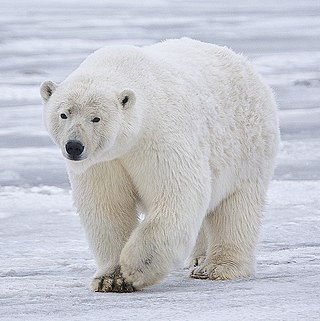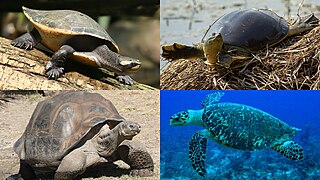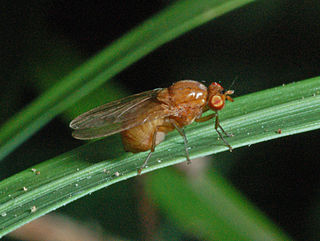Related Research Articles

Gorillas are herbivorous, predominantly ground-dwelling great apes that inhabit the tropical forests of equatorial Africa. The genus Gorilla is divided into two species: the eastern gorilla and the western gorilla, and either four or five subspecies. The DNA of gorillas is highly similar to that of humans, from 95 to 99% depending on what is included, and they are the next closest living relatives to humans after chimpanzees and bonobos.

Primates are a diverse order of mammals. They are divided into the strepsirrhines, which include the lemurs, galagos, and lorisids, and the haplorhines, which include the tarsiers and the simians. Primates arose 85–55 million years ago first from small terrestrial mammals, which adapted to living in the trees of tropical forests: many primate characteristics represent adaptations to life in this challenging environment, including large brains, visual acuity, color vision, a shoulder girdle allowing a large degree of movement in the shoulder joint, and dexterous hands. Primates range in size from Madame Berthe's mouse lemur, which weighs 30 g (1 oz), to the eastern gorilla, weighing over 200 kg (440 lb). There are 376–524 species of living primates, depending on which classification is used. New primate species continue to be discovered: over 25 species were described in the 2000s, 36 in the 2010s, and three in the 2020s.

The polar bear is a large bear native to the Arctic and nearby areas. It is closely related to the brown bear, and the two species can interbreed. The polar bear is the largest extant species of bear and land carnivore, with adult males weighing 350–700 kg (770–1,540 lb). The species is sexually dimorphic, as adult females are much smaller. The polar bear is white- or yellowish-furred with black skin and a thick layer of fat. It is more slender than the brown bear, with a narrower skull, longer neck and lower shoulder hump. Its teeth are sharper and more adapted to cutting meat. The paws are large and allow the bear to walk on ice and paddle in the water.

Turtles are an order of reptiles known as Testudines, characterized by a special shell developed mainly from their ribs. Modern turtles are divided into two major groups, the Pleurodira and Cryptodira, which differ in the way the head retracts. There are 360 living and recently extinct species of turtles, including land-dwelling tortoises and freshwater terrapins. They are found on most continents, some islands and, in the case of sea turtles, much of the ocean. Like other amniotes they breathe air and do not lay eggs underwater, although many species live in or around water.

Mackerel is a common name applied to a number of different species of pelagic fish, mostly from the family Scombridae. They are found in both temperate and tropical seas, mostly living along the coast or offshore in the oceanic environment.

The Caridea, commonly known as caridean shrimp or true shrimp, from the Greek word καρίς, καρίδος, are an infraorder of shrimp within the order Decapoda. This infraorder contains all species of true shrimp. They are found widely around the world in both fresh and salt water. Many other animals with similar names – such as the mud shrimp of Axiidea and the boxer shrimp of Stenopodidea – are not true shrimp, but many have evolved features similar to true shrimp.

Blanding's turtle is a semi-aquatic turtle of the family Emydidae. This species is native to central and eastern parts of Canada and the United States. It is considered to be an endangered species throughout much of its range. Blanding's turtle is of interest in longevity research, as it shows few or no common signs of aging and is physically active and capable of reproduction into eight or nine decades of life.

The Lauxaniidae are a family of acalyptrate flies. They generally are small flies with large compound eyes that often are brightly coloured in life, sometimes with characteristic horizontal stripes, such as in Cestrotus species. Many species have variegated patterns on their wings, but in contrast they generally do not have variegated bodies, except for genera such as Cestrotus, whose camouflage mimics lichens or the texture of granitic rocks.

Cyclanorbis is a genus of softshell turtles in the family Trionychidae. The genus is endemic to Africa.

A hermaphrodite is a sexually reproducing organism that produces both male and female gametes. Animal species in which individuals are of different sexes, either male or female but not both, are gonochoric, which is the opposite of hermaphroditic.

An organism's sex is female if it produces the ovum, the type of gamete that fuses with the male gamete during sexual reproduction.

Bats are mammals of the order Chiroptera. With their forelimbs adapted as wings, they are the only mammals capable of true and sustained flight. Bats are more agile in flight than most birds, flying with their very long spread-out digits covered with a thin membrane or patagium. The smallest bat, and arguably the smallest extant mammal, is Kitti's hog-nosed bat, which is 29–34 millimetres in length, 150 mm (6 in) across the wings and 2–2.6 g in mass. The largest bats are the flying foxes, with the giant golden-crowned flying fox reaching a weight of 1.6 kg and having a wingspan of 1.7 m.

Sapromyza neozelandica, commonly called the brown striped litter fly, is an endemic fly of New Zealand.

Sapromyza (Sapromyzosoma) quadricincta, is a species of small flies of the family Lauxaniidae present in Europe.

Sapromyza halidayi is a species of small flies of the family Lauxaniidae.

Sapromyza quadripunctata is a species of fly in the family Lauxaniidae. It is found in the Palearctic.
Sapromyza brachysoma is a species of fly in the family Lauxaniidae.
Sapromyza rotundicornis is a species of fly in the family Lauxaniidae.

Cheilosia psilophthalma is a Palearctic hoverfly closely related and very similar to Cheilosia latigenis, Cheilosia mutabilis and Cheilosia urbana . It is a rare and little known species recorded from Scandinavia, Ireland, Britain, France, Poland, Switzerland, Greece, Montenegro, Serbia, Ukraine and European Russia. Flowers visited include Acer platanoides, Anemone nemorosa, Primula veris, Prunus spinosa and Salix spp. Cheilosia psilophthalma flies in April and May. Open, grassy areas within sparse woodland and unimproved, montane subalpine grassland are preferred habitats. Larvae are recorded as developing in Hieracium pilosella and Hieracium caespitosum.
References
- ↑ Schiner, I. R. (1868). . Diptera. In [Wullerstorf-Urbair, B. von (in charge)], Reise der osterreichischen Fregatte Novara. Zool. 2(1)B. Wien: K. Gerold's Sohn. pp. vi + 388 pp., 4 pls.
- ↑ "Search all names - Results for "sapromyza oestrachion"". Species 2000 & ITIS Catalogue of Life: 2011 Annual Checklist. Retrieved 24 September 2012.
- ↑ Systema Dipterorum. Pape T. & Thompson F.C. (eds), 2011-01-06